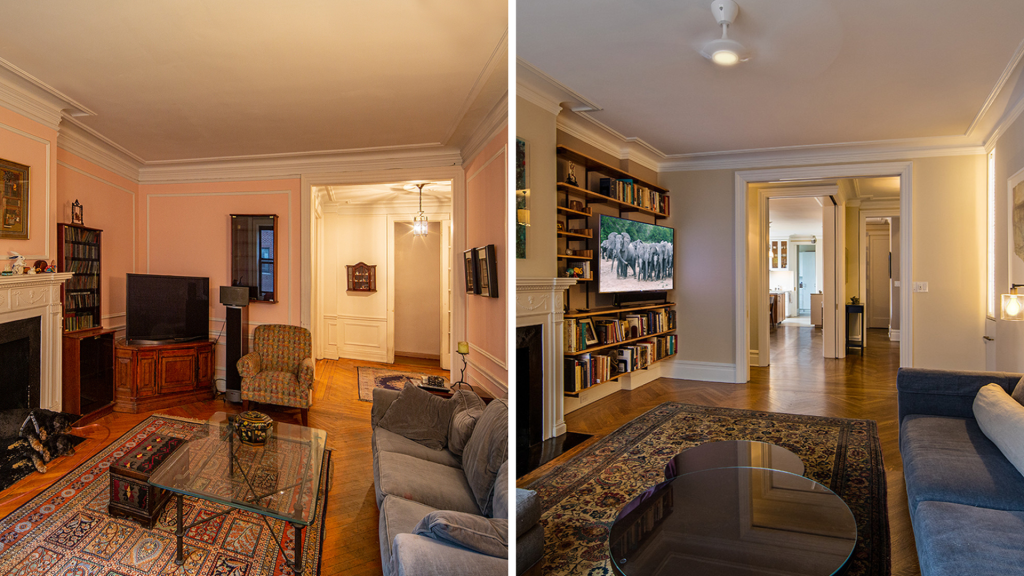
The Classic Six Apartment is the most common New York City apartment type built between 1920-1940’s and is an iconic New York Apartment style catering to the city’s burgeoning middle and upper-class families. These apartments can be found primarily in neighborhoods like the Upper West Side, Upper East Side, and Brooklyn Heights.
The Classic Six is generously sized, and designed for another era: one of small bathrooms, servants, and a time when cooking was not a family activity. There are six rooms, not counting bathrooms, foyers, or corridors:
Spaciousness and natural Illumination are achieved with high ceiling heights, ranging from 9’6” to 12 feet, and large windows. The entertaining rooms are elegant with architectural details, including plaster crown moldings and white oak parquet hardwood floors. Fireplaces, either wood-burning or briefly gas-powered, serve as focal points in the living rooms. Rooms are separated by glass-paned and wood-paneled doors. Wainscoting and decorative archways further contribute to the aesthetic.
The older the building, the more pronounced the higher the ceilings, larger windows and rooms, wider corridors, and more generous crown moldings.
Bedrooms and the corridors that connect them exhibit a more modest approach with simpler plaster moldings, wood trims, and red-oak strip flooring. In addition, pre-war apartments often have very small and limited bathroom spaces, sometimes augmented by sink closets.
At the core of the classic-six apartment lies a specific spatial arrangement that harkens back to the era in which these residences were constructed. The foyer, living room, and dining room collectively form the designated zones for hosting and socializing.
There is a harmonious flow for entertaining. The living room and dining room form an elegant pair, seamlessly connected by gracious entranceways or French doors. This fluid transition between spaces allows for a natural flow, perfect for entertaining guests.

Distinct zones of public and private areas are created through separations created by foyers, galleries, vestibules, and corridors. Private quarters and servant’s spaces are secluded. In contrast to the entertaining spaces, the bedrooms offer a more intimate and private setting, typically accessed via a long hallway and featuring modest closet spaces. The servant’s quarters, a relic of the era, were quite cramped, comprising a small bedroom and bathroom.
The Classic Six was built for a time of live-in servants, clearly separated spaces were predominant, and plumbing was limited. As times have changed, these Classic apartments flourish when they are adapted for contemporary life. At AKA, we have developed GrandFlow℠, a distinctive approach to transforming these historic homes that optimizes the sense of openness and flow while preserving their architectural character. This method creates seamless transitions between spaces – integrating kitchens with living areas, using strategic door placements, and optimizing sightlines – all while maintaining the elegant proportions and details that make Classic Six apartments so special.
Pro Tip: When renovating a Classic Six, focus on adapting the kitchen and service areas first, as these spaces typically need the most updating for modern living.

The transition from New York City brownstones to the classic-six apartment buildings was a gradual process that occurred in the late 19th and early 20th centuries. Between the 1890s-1920s, taller apartment buildings started to be constructed, enabled by new construction technologies like steel framing and elevators. This allowed for the development of the “classic six” layout – apartments with a formal entry foyer, living room, dining room, two bedrooms, a maid’s room (third bedroom), and kitchen. These spacious prewar apartments with high ceilings and elegant details were built for the upwardly mobile middle and upper classes.
As the twentieth century progressed, aspiration fueled the classic six’s proliferation across the city. The burgeoning middle class, riding successive waves of economic prosperity, sought to emulate the lifestyles of the upper crust. The classic six embodied this upward mobility, its generously proportioned rooms and gracious entertaining spaces symbolizing the attainment of the quintessential New York dream.
For New Yorkers seeking the perfect blend of historical charm and when renovated, modern convenience, the classic-six apartment remains an enduring icon. Epitomizing the city’s rich architectural heritage, these spacious dwellings offer a harmonious balance between formal entertaining and comfortable family living.
Did you find this article helpful?
Leave comments for us below